《体育英语》课程教学大纲
- 格式:doc
- 大小:72.00 KB
- 文档页数:4
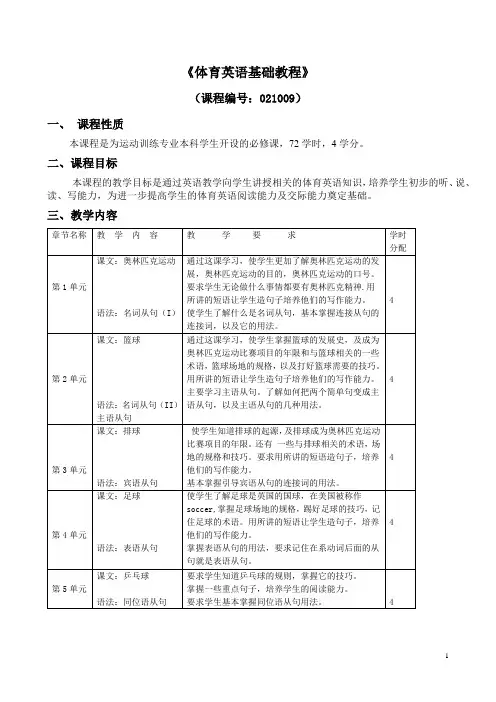
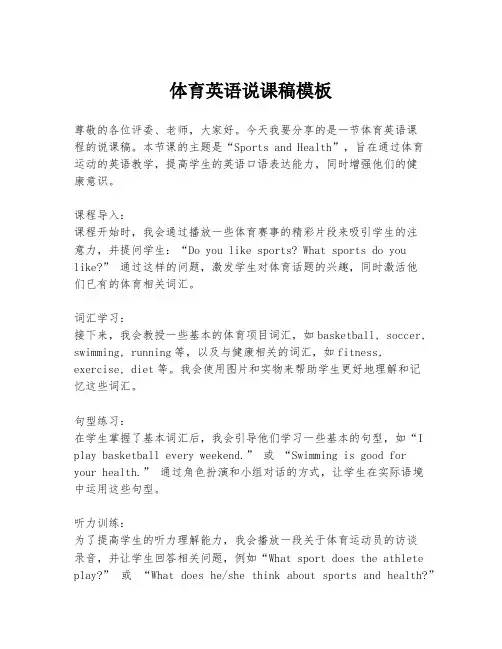
体育英语说课稿模板尊敬的各位评委、老师,大家好。
今天我要分享的是一节体育英语课程的说课稿。
本节课的主题是“Sports and Health”,旨在通过体育运动的英语教学,提高学生的英语口语表达能力,同时增强他们的健康意识。
课程导入:课程开始时,我会通过播放一些体育赛事的精彩片段来吸引学生的注意力,并提问学生:“Do you like sports? What sports do you like?” 通过这样的问题,激发学生对体育话题的兴趣,同时激活他们已有的体育相关词汇。
词汇学习:接下来,我会教授一些基本的体育项目词汇,如basketball, soccer, swimming, running等,以及与健康相关的词汇,如fitness, exercise, diet等。
我会使用图片和实物来帮助学生更好地理解和记忆这些词汇。
句型练习:在学生掌握了基本词汇后,我会引导他们学习一些基本的句型,如“I play basketball every weekend.” 或“Swimming is good foryour health.” 通过角色扮演和小组对话的方式,让学生在实际语境中运用这些句型。
听力训练:为了提高学生的听力理解能力,我会播放一段关于体育运动员的访谈录音,并让学生回答相关问题,例如“What sport does the athlete play?” 或“What does he/she think about sports and health?”口语表达:在听力训练之后,我会组织一个小组讨论,主题是“My Favorite Sport and Why”。
每个学生都需要用英语表达自己最喜欢的运动以及原因。
这不仅能锻炼学生的口语能力,还能增进学生之间的交流。
文化拓展:在课程的最后,我会简要介绍一些国际知名的体育赛事,如Olympic Games, World Cup等,并讨论体育在不同文化中的意义和影响。
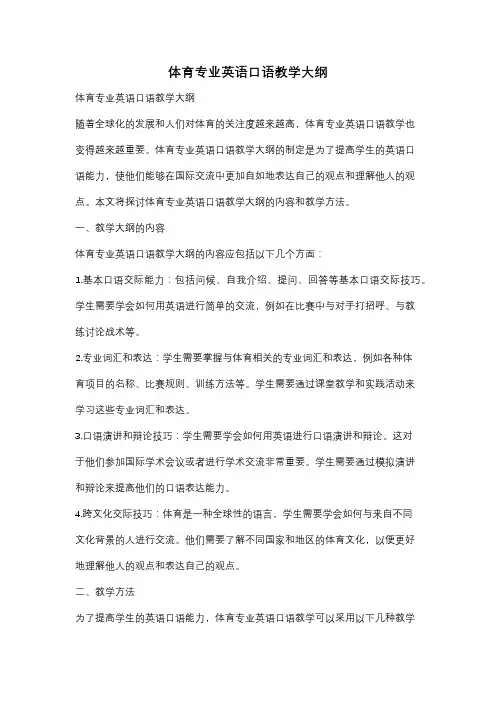
体育专业英语口语教学大纲体育专业英语口语教学大纲随着全球化的发展和人们对体育的关注度越来越高,体育专业英语口语教学也变得越来越重要。
体育专业英语口语教学大纲的制定是为了提高学生的英语口语能力,使他们能够在国际交流中更加自如地表达自己的观点和理解他人的观点。
本文将探讨体育专业英语口语教学大纲的内容和教学方法。
一、教学大纲的内容体育专业英语口语教学大纲的内容应包括以下几个方面:1.基本口语交际能力:包括问候、自我介绍、提问、回答等基本口语交际技巧。
学生需要学会如何用英语进行简单的交流,例如在比赛中与对手打招呼、与教练讨论战术等。
2.专业词汇和表达:学生需要掌握与体育相关的专业词汇和表达,例如各种体育项目的名称、比赛规则、训练方法等。
学生需要通过课堂教学和实践活动来学习这些专业词汇和表达。
3.口语演讲和辩论技巧:学生需要学会如何用英语进行口语演讲和辩论。
这对于他们参加国际学术会议或者进行学术交流非常重要。
学生需要通过模拟演讲和辩论来提高他们的口语表达能力。
4.跨文化交际技巧:体育是一种全球性的语言,学生需要学会如何与来自不同文化背景的人进行交流。
他们需要了解不同国家和地区的体育文化,以便更好地理解他人的观点和表达自己的观点。
二、教学方法为了提高学生的英语口语能力,体育专业英语口语教学可以采用以下几种教学方法:1.情景模拟:通过模拟真实的体育场景,例如比赛、训练和会议等,让学生在实践中学习口语表达能力。
教师可以扮演不同的角色,与学生进行对话练习。
2.角色扮演:学生可以分成小组,扮演不同的角色,在特定的情境中进行口语练习。
例如,一组学生可以扮演教练和运动员,在训练场上进行对话练习。
3.实地考察:学生可以参观体育场馆、运动训练中心等实地考察,通过观察和体验来学习体育专业英语口语。
在实地考察中,学生可以与工作人员进行交流,提高他们的口语表达能力。
4.听力训练:学生可以通过听力训练来提高他们的口语理解和表达能力。
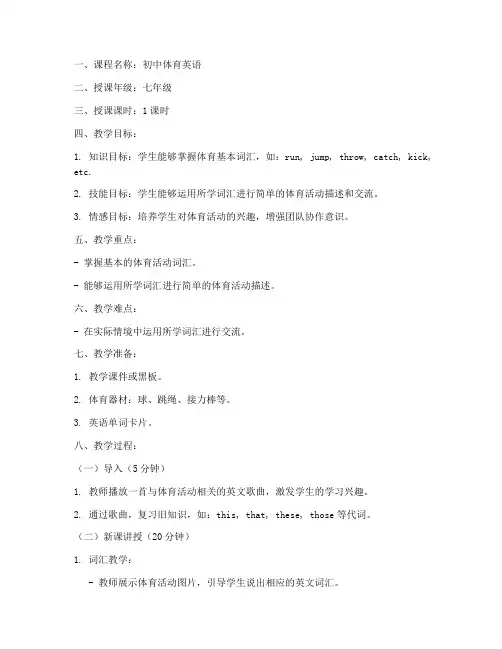
一、课程名称:初中体育英语二、授课年级:七年级三、授课课时:1课时四、教学目标:1. 知识目标:学生能够掌握体育基本词汇,如:run, jump, throw, catch, kick, etc.2. 技能目标:学生能够运用所学词汇进行简单的体育活动描述和交流。
3. 情感目标:培养学生对体育活动的兴趣,增强团队协作意识。
五、教学重点:- 掌握基本的体育活动词汇。
- 能够运用所学词汇进行简单的体育活动描述。
六、教学难点:- 在实际情境中运用所学词汇进行交流。
七、教学准备:1. 教学课件或黑板。
2. 体育器材:球、跳绳、接力棒等。
3. 英语单词卡片。
八、教学过程:(一)导入(5分钟)1. 教师播放一首与体育活动相关的英文歌曲,激发学生的学习兴趣。
2. 通过歌曲,复习旧知识,如:this, that, these, those等代词。
(二)新课讲授(20分钟)1. 词汇教学:- 教师展示体育活动图片,引导学生说出相应的英文词汇。
- 例如:展示跑步的图片,引导学生说出“run”。
- 教师带领学生朗读单词,并解释其意思和用法。
- 学生跟读并模仿发音。
2. 句子教学:- 教师展示体育活动场景,引导学生运用所学词汇构造句子。
- 例如:展示足球比赛的场景,引导学生说出“I like to kick the ball”。
- 教师示范句子,学生跟读并模仿。
3. 游戏环节:- 教师组织学生进行简单的体育游戏,如:传球、跳绳等。
- 游戏中,学生运用所学词汇进行交流。
(三)巩固练习(15分钟)1. 小组活动:- 学生分成小组,用所学词汇进行体育活动描述。
- 例如:描述一次足球比赛、一次跳绳比赛等。
2. 角色扮演:- 教师设置情景,学生进行角色扮演,运用所学词汇进行对话。
(四)总结与反馈(5分钟)1. 教师对学生的课堂表现进行总结,表扬优秀的学生。
2. 学生分享自己的学习心得。
3. 教师布置课后作业,如:收集与体育活动相关的英文词汇。
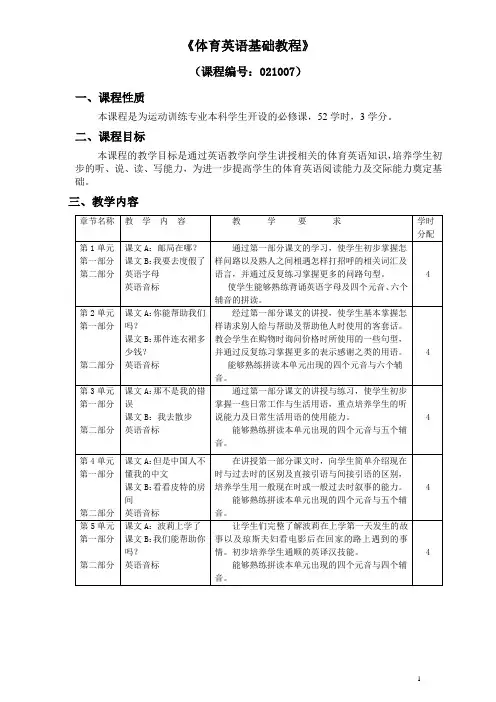
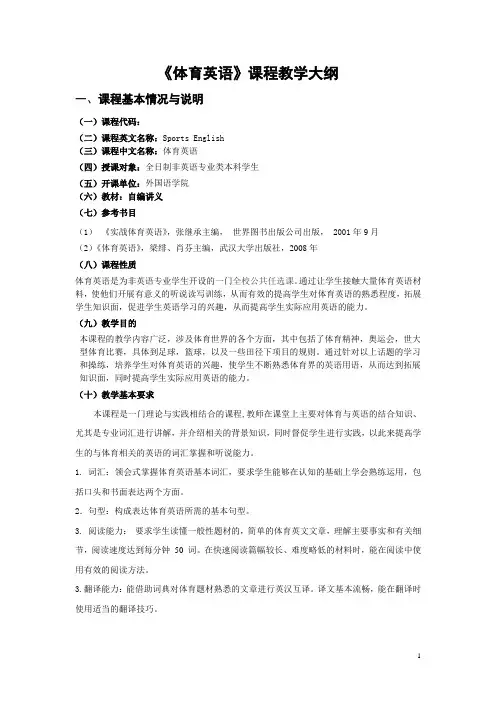
《体育英语》课程教学大纲一、课程基本情况与说明(一)课程代码:(二)课程英文名称:Sports English(三)课程中文名称:体育英语(四)授课对象:全日制非英语专业类本科学生(五)开课单位:外国语学院(六)教材:自编讲义(七)参考书目(1)《实战体育英语》,张继承主编,世界图书出版公司出版, 2001年9月(2)《体育英语》,梁绯、肖芬主编,武汉大学出版社,2008年(八)课程性质体育英语是为非英语专业学生开设的一门全校公共任选课。
通过让学生接触大量体育英语材料,使他们开展有意义的听说读写训练,从而有效的提高学生对体育英语的熟悉程度,拓展学生知识面,促进学生英语学习的兴趣,从而提高学生实际应用英语的能力。
(九)教学目的本课程的教学内容广泛,涉及体育世界的各个方面,其中包括了体育精神,奥运会,世大型体育比赛,具体到足球,篮球,以及一些田径下项目的规则。
通过针对以上话题的学习和操练,培养学生对体育英语的兴趣,使学生不断熟悉体育界的英语用语,从而达到拓展知识面,同时提高学生实际应用英语的能力。
(十)教学基本要求本课程是一门理论与实践相结合的课程,教师在课堂上主要对体育与英语的结合知识、尤其是专业词汇进行讲解,并介绍相关的背景知识,同时督促学生进行实践,以此来提高学生的与体育相关的英语的词汇掌握和听说能力。
1. 词汇:领会式掌握体育英语基本词汇,要求学生能够在认知的基础上学会熟练运用,包括口头和书面表达两个方面。
2.句型:构成表达体育英语所需的基本句型。
3. 阅读能力:要求学生读懂一般性题材的,简单的体育英文文章,理解主要事实和有关细节,阅读速度达到每分钟50 词。
在快速阅读篇幅较长、难度略低的材料时,能在阅读中使用有效的阅读方法。
3.翻译能力:能借助词典对体育题材熟悉的文章进行英汉互译。
译文基本流畅,能在翻译时使用适当的翻译技巧。
4.口语表达能力:能掌握构成表达体育英语所需的基本句型,能完成一般性体育方面的交流,用词恰当,语意连贯。

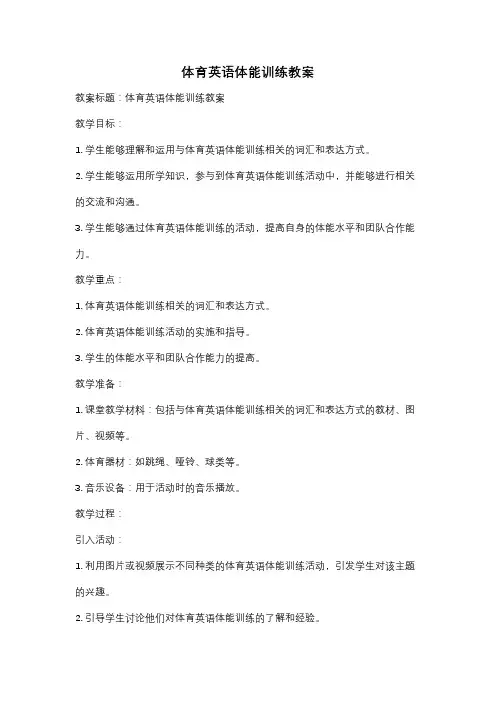
体育英语体能训练教案教案标题:体育英语体能训练教案教学目标:1. 学生能够理解和运用与体育英语体能训练相关的词汇和表达方式。
2. 学生能够运用所学知识,参与到体育英语体能训练活动中,并能够进行相关的交流和沟通。
3. 学生能够通过体育英语体能训练的活动,提高自身的体能水平和团队合作能力。
教学重点:1. 体育英语体能训练相关的词汇和表达方式。
2. 体育英语体能训练活动的实施和指导。
3. 学生的体能水平和团队合作能力的提高。
教学准备:1. 课堂教学材料:包括与体育英语体能训练相关的词汇和表达方式的教材、图片、视频等。
2. 体育器材:如跳绳、哑铃、球类等。
3. 音乐设备:用于活动时的音乐播放。
教学过程:引入活动:1. 利用图片或视频展示不同种类的体育英语体能训练活动,引发学生对该主题的兴趣。
2. 引导学生讨论他们对体育英语体能训练的了解和经验。
词汇和表达方式学习:1. 通过教材和多媒体展示,介绍与体育英语体能训练相关的常用词汇和表达方式,如warm-up(热身)、stretching(拉伸)、endurance(耐力)等。
2. 进行课堂练习,让学生边学边用,巩固所学的词汇和表达方式。
体育英语体能训练活动:1. 分组活动:将学生分成小组,每个小组选择一个体育英语体能训练活动,如跳绳、仰卧起坐等,并制定相应的训练计划。
2. 活动实施:学生按照训练计划进行体育英语体能训练活动,并在活动中使用所学的体育英语词汇和表达方式。
3. 指导和辅导:教师在活动过程中提供必要的指导和辅导,确保学生的安全和正确的训练方法。
总结反思:1. 学生进行小组展示,分享他们的体育英语体能训练活动经验和收获。
2. 教师总结本节课的教学内容和学生的表现,并进行必要的反思和评价。
3. 鼓励学生继续参与体育英语体能训练活动,提高自身的体能水平和团队合作能力。
教学延伸:1. 学生可以通过自主学习和研究,了解更多与体育英语体能训练相关的知识和技巧。

大学英语四--体育英语教案滁州学院外国语学院体育英语授课教师李林授课班级体教授课地点2203 教材《体育英语》. 何庆忠、张惠珍. 2009. 苏州大学出版社.授课内容Unit One FootballSection A学时 2 periods教学目的1.Introduce students to the origin and development of football, the requiredequipment and the rules of football matches;2.Enable students to understand and utilize words and expressions concerningfootball.教学重点与难点Teaching emphasis: Acquisition of athletic terminology. Teaching difficulties: Understanding of the rules of football.教学方法与手段Teaching method:heuristic teachingTeaching aids:Multi-media andblackboard教学参考书1.《大学体育英语》. 《大学英语选修课/学科课程系列教材》项目组. 2008. 高等教育出版社.2.《实用体育英语》. 顾运筠等. 2011. 高等教育出版社.3.《体育专业英语》. 刘成. 2009. 暨南大学出版社.教学进程I.Teaching Plan (90 minutes)1.Lead-in (10 minutes)2.V ocabulary foundation (35 minutes)3.Text analysis (40 minutes)4.Assignment (5 minutes)II.Teaching Steps1. Lead-in (10 minutes)Teacher asks students to enumerate their favorite football stars and explain why they are drawn to this particular sport.2. Vocabulary foundation (35 minutes)Teacher asks students to list all the terms they regard related to football, and teacher provides the closest equivalents for these words and expressions in English.Chinese English足球football美式足球American football板球cricket颠球juggle比赛场地field of play草坪pitch围度dimension外场球员outfield player守门员goalkeeper替补球员substitute球员比赛装备player’s equipment护胫shin pad主裁判referee助理裁判;边裁assistant referee越位offside犯规foul手球handball比赛时间duration of the match伤停补时injury time加时赛knockout match平分tie开始比赛和重新开始比赛start and restart of play开球kick-off进球score a goal边线side line掷界外球throw-in进攻offence防守defense任意球free kick直接任意球direct free kick点球penalty kick点球决胜penalty-shootout犯规和不当行为foul and misconduct对手opponent黄牌或红牌yellow or red card防守队员犯规defended player foul罚球区penalty box击中门柱strike the bar门球goal kick角球corner kick底线goal line3. Text analysis (40 minutes)Step one: Teacher asks students to glance the text in 15 minutes and consider the following questions:1) When did football come into being and how did it become a worldwide game?2) What equipment is required by this sport?3) What are the specific rules of football matches?Step two: Teacher checks answers with students and draws student s’ attention to the actual usage of words and expressions concerning football.4. Assignment (5 minutes)1. Group project: Teacher arranges students into groups and asks each group to select one memorable football match and make a full commentary on the match.2. Teacher asks students to finish the exercises that follow the text.体育英语授课教师李林授课班级体教授课地点2203 教材《体育英语》. 何庆忠、张惠珍. 2009. 苏州大学出版社.授课内容Unit One FootballSection B学时 2 periods教学目的1.Introduce students to the football culture and the football legends;2.Consolidate students’ability to understand and utilize words and expressionsconcerning football.教学重点与难点Teaching emphasis: Acquisition of athletic terminology. Teaching difficulties: Understanding of the football culture.教学方法与手段Teaching method:heuristic teachingTeaching aids:Multi-media andblackboard教学参考书1.《大学体育英语》. 《大学英语选修课/学科课程系列教材》项目组. 2008. 高等教育出版社.2.《实用体育英语》. 顾运筠等. 2011. 高等教育出版社.3.《体育专业英语》. 刘成. 2009. 暨南大学出版社.教学进程I.Teaching Plan (90 minutes)1.Group project (20 minutes)2.Exercises (25 minutes)3.Text analysis (40 minutes)4.Assignment (5 minutes)II.Teaching Steps1. Group project (20 minutes)Teacher asks students to make a full commentary on the football match chosen by the group member.2. Exercises (25 minutes)Teacher checks answers to the exercises with students and puts emphasis on the application of athletic terminology.3. Text analysis (40 minutes)Step one: Teacher asks students to glance the text in 10 minutes and consider the following questions:1) What made Maradona famous all over the world?2) Why was Maradona banned from football matches twice?3) What resulted in his retirement?Step two: Teacher checks answers with students.Step three: Teacher asks students to finish the exercises that follow the text and checks answers with them.4. Assignment (5 minutes)Composition: Suppose you are the newly-appointed coach of the national football team. Write a package of proposals concerning the ways to improve the performance of the football players.体育英语授课教师李林授课班级体教授课地点2203 教材《体育英语》. 何庆忠、张惠珍. 2009. 苏州大学出版社.授课内容Unit Two BasketballSection A学时 2 periods教学目的1.Introduce students to the origin and development of basketball, the requiredequipment and the rules of basketball matches;2.Enable students to understand and utilize vocabulary and expressions concerningbasketball.教学重点与难点Teaching emphasis: Acquisition of athletic terminology. Teaching difficulties: Understanding of the rules of basketball.教学方法与手段Teaching method:heuristic teachingTeaching aids:Multi-media andblackboard教学参考书1.《大学体育英语》. 《大学英语选修课/学科课程系列教材》项目组. 2008. 高等教育出版社.2. 《实用体育英语》. 顾运筠等. 2011. 高等教育出版社.3. 《体育专业英语》. 刘成. 2009. 暨南大学出版社.教学进程I.Teaching Plan (90 minutes)1. Lead-in (10 minutes)2. V ocabulary foundation (35 minutes)3. Text analysis (40 minutes)4. Assignment (5 minutes)II.Teaching Steps1. Lead-in (10 minutes)Teacher asks students to enumerate their favorite basketball stars and explain why they are fond of these stars.2. Vocabulary Foundation (35 minutes)Teacher asks students to list all the terms they regard related to basketball, and teacher provides the closest equivalents for these words and expressions in English.Chinese English推进propel篮筐hoop投篮shoot弹跳bounce破坏性身体接触disruptive physical contact 运球dribble进攻的offensive防守的defensive中锋center前锋forward后卫guard能吸引观众的运动spectator sport 锦标赛tournament 得分超过对手outscore one’s opponent 1节quarter 中场休息half-time break 比赛延长时间overtime period 规定时间allot time选手名单player roster换人substitution监督oversee战术strategy暂停时间time-out 比赛停止计时clock stoppage 裁判umpire主裁判crew chief矩形rectangle规模dimension不利影响adverse effect犯规violation因被罚而丧失所有权forfeit 走步traveling干预interfere with干扰球goaltending控球后卫point guard得分后卫shooting guard小前锋small forward打前锋power forward区域防守zone defense盯人防守man-to-man defense卡位,切入cut掩护screen跑动战术motion offense立定投篮set shot跳起投篮jump shot带球上篮lay up扣篮slam dunk传球pass胸前传球chest pass反弹传球bounce pass头上传球overhead pass快攻第一传outlet pass不看队友传球no-look pass背后传球behind-the-back pass3. Text analysis (40 minutes)Step one: Teacher asks students to glance the text in 15 minutes and consider the following questions:1) How can we account for the global popularity of basketball?2) What equipment is required by this sport?3) What are the specific rules of basketball matches?Step two: Teacher checks answers with students and draws student s’ attention to the actual usage of words and expressions concerning basketball.4. Assignment (5 minutes)1. Group project: Teacher arranges students into groups and asks each group to select one memorable basketball match and make a full commentary on the match.2. Teacher asks students to finish the exercises that follow the text.体育英语授课教师李林授课班级体教授课地点2203 教材《体育英语》. 何庆忠、张惠珍. 2009. 苏州大学出版社.授课内容Unit Two BasketballSection B学时 2 periods教学目的1.Introduce students to the basketball culture and the basketball legends;2.Consolidate students’ability to understand and utilize words and expressionsconcerning basketball.教学重点与难点Teaching emphasis: Acquisition of athletic terminology. Teaching difficulties: Understanding of the basketball culture.教学方法与手段Teaching method:heuristic teachingTeaching aids:Multi-media andblackboard教学参考书1.《大学体育英语》. 《大学英语选修课/学科课程系列教材》项目组. 2008. 高等教育出版社.2.《实用体育英语》. 顾运筠等. 2011. 高等教育出版社.3.《体育专业英语》. 刘成. 2009. 暨南大学出版社.教学进程I.Teaching Plan (90 minutes)1.Group project (20 minutes)2.Exercises (25 minutes)3.Text analysis (40 minutes)4.Assignment (5 minutes)II.Teaching Steps1. Group project (20 minutes)Teacher asks students to make a full commentary on the basketball match chosen by the group member.2. Exercises (25 minutes)Teacher checks answers to the exercises with students and puts emphasis on the application of athletic terminology.3. Text analysis (40 minutes)Step one: Teacher asks students to glance the text in 10 minutes and consider the following questions:1) Could you make a bibliographical sketch of Michael Jordan?2) What brought Jordan enormous fame?Step two: Teacher checks answers with students.Step three: Teacher asks students to finish the exercises that follow the text and checks answers with them.4. Assignment (5 minutes)Composition: Suppose you are a member of the Chinese Basketball Association. Write an invitation letter to persuade Jordan to take over the Chinese national basketball team.体育英语授课教师李林授课班级体教授课地点2203 教材《体育英语》. 何庆忠、张惠珍. 2009. 苏州大学出版社.授课内容Unit Three VolleyballSection A学时 2 periods教学目的1.Introduce students to the origin and development of volleyball, the requiredequipment and the rules of volleyball matches;2.Enable students to understand and utilize vocabulary and expressions concerningvolleyball.教学重点与难点Teaching emphasis: Acquisition of athletic terminology. Teaching difficulties: Understanding of the rules of volleyball.教学方法与手段Teaching method:heuristic teachingTeaching aids:Multi-media andblackboard教学参考书1.《大学体育英语》. 《大学英语选修课/学科课程系列教材》项目组2008. 高等教育出版社.2.《实用体育英语》. 顾运筠等. 2011. 高等教育出版社.3.《体育专业英语》. 刘成. 2009. 暨南大学出版社.教学进程I.Teaching Plan (90 minutes)1. Lead-in (10 minutes)2. V ocabulary foundation (35 minutes)3. Text analysis (40 minutes)4. Assignment (5 minutes)II.Teaching Steps1. Lead-in (10 minutes)Teacher asks students to enumerate their favorite volleyball stars and explain why they are drawn to this particular sport.2. Vocabulary Foundation (35 minutes)Teacher asks students to list all the terms they regard related to volleyball, and teacher provides the closest equivalents for these words and expressions in English.Chinese English投,掷toss抛物线,运行轨道trajectory扣球spike进攻方team on offense防守方team on defense垫球dig回合rally连续地in succession自由人libero player矩形的rectangular对称的symmetrical球队构成team composition一局set最少领先 a minimum lead of球队出场名单team’s starting line-up教练coach位置轮换rotation比赛进行和终止ball in and ball out发球service发球时遮挡对方视线screening拦网block比赛暂停regular game interruption中场休息interval交换场地change of courts裁判组referee corps3. Text analysis (40 minutes)Step one: Teacher asks students to glance the text in 15 minutes and consider the following questions:1) When did volleyball come into being and who invented this sport?2) What equipment is required by this sport?3) What are the specific rules of volleyball matches?4) How can we account for the fact that volleyball is less popular than football and basketball?Step two: Teacher checks answers with students and draws student s’ attention to the actual usage of words and expressions concerning volleyball.4. Assignment (5 minutes)1. Group project: Teacher arranges students into groups and asks each group to select one memorable volleyball match and make a full commentary on the match.2. Teacher asks students to finish the exercises that follow the text.体育英语授课教师李林授课班级体教授课地点2203 教材《体育英语》. 何庆忠、张惠珍. 2009. 苏州大学出版社.授课内容Unit Three VolleyballSection B学时 2 periods教学目的1.Introduce students to the volleyball culture and the volleyball legends;2.Consolidate students’ability to understand and utilize words and expressionsconcerning volleyball.教学重点与难点Teaching emphasis: Acquisition of athletic terminology. Teaching difficulties: Understanding of the volleyball culture.教学方法与手段Teaching method:heuristic teachingTeaching aids:Multi-media andblackboard教学参考书1.《大学体育英语》. 《大学英语选修课/学科课程系列教材》项目组. 2008. 高等教育出版社.2.《实用体育英语》. 顾运筠等. 2011. 高等教育出版社.3.《体育专业英语》. 刘成. 2009. 暨南大学出版社.教学进程I.Teaching Plan (90 minutes)1.Group project (20 minutes)2.Exercises (25 minutes)3.Text analysis (40 minutes)4.Assignment (5 minutes)II.Teaching Steps1. Group project (20 minutes)Teacher asks students to make a full commentary on the volleyball match chosen by the group member.2. Exercises (25 minutes)Teacher checks answers to the exercises with students and puts emphasis on the application of athletic terminology.3. Text analysis (40 minutes)Step one: Teacher asks students to glance the text in 10 minutes and consider the following questions:1) At first look, how did Mireya Luis impress people?2) Why was Mireya Luis compared to Michael Jordan although they played different sports?3) Why was Luis the most charismatic reputable player of the 1990s?Step two: Teacher checks answers with students.Step three: Teacher asks students to finish the exercises that follow the text and checks answers with them.4. Assignment (5 minutes)Composition: Suppose you are a volleyball fan. Write a letter to the Chairman of the World Volleyball Association and bid for your city to stage the next World Championship.体育英语授课教师李林授课班级体教授课地点2203 教材《体育英语》. 何庆忠、张惠珍. 2009. 苏州大学出版社.授课内容Unit Four Table TennisSection A学时 2 periods教学目的1.Introduce students to the origin and development of table tennis, the requiredequipment and the rules of table tennis matches;2.Enable students to understand and utilize words and expressions concerning tabletennis.教学重点与难点Teaching emphasis: Acquisition of athletic terminology. Teaching difficulties: Understanding of the rules of table tennis.教学方法与手段Teaching method:heuristic teachingTeaching aids:Multi-media andblackboard教学参考书1.《大学体育英语》. 《大学英语选修课/学科课程系列教材》项目组. 2008. 高等教育出版社.2.《实用体育英语》. 顾运筠等. 2011. 高等教育出版社.3.《体育专业英语》. 刘成. 2009. 暨南大学出版社.教学进程I.Teaching Plan (90 minutes)1.Lead-in (10 minutes)2.V ocabulary foundation (35 minutes)3.Text analysis (40 minutes)4.Assignment (5 minutes)II.Teaching Steps1. Lead-in (10 minutes)Teacher asks students to enumerate their favorite table tennis stars and explain why they are fond of these stars.2. Vocabulary Foundation (35 minutes)Teacher asks students to list all the terms they regard related to table tennis, and teacher provides the closest equivalents for these words and expressions in English.Chinese English中世纪的medieval边线side lines底线end lines悬架suspension夹子clamp球形的spherical手掌palm互不得分let旋转spin回球return阻挡obstruct垂直的vertical水平的horizontal模仿imitation狂热craze改进的modified复兴revive本质上in essence3. Text analysis (40 minutes)Step one: Teacher asks students to glance the text in 15 minutes and consider the following questions:1) What was the origin of table tennis?2) When did this sport spread to the East?3) What equipment is required by this sport?4) What are the specific rules of table tennis matches?Step two: Teacher checks answers with students and draws student s’ attention to the actual usage of words and expressions concerning table tennis.4. Assignment (5 minutes)1. Group project: Teacher arranges students into groups and asks each group to select one memorable table tennis match and make a full commentary on the match.2. Teacher asks students to finish the exercises that follow the text.体育英语授课教师李林授课班级体教授课地点2203 教材《体育英语》. 何庆忠、张惠珍. 2009. 苏州大学出版社.授课内容Unit Four Table TennisSection B学时 2 periods教学目的1.Introduce students to the table tennis culture and the table tennis legends;2.Consolidate students’ability to understand and utilize words and expressionsconcerning table tennis.教学重点与难点Teaching emphasis: Acquisition of athletic terminology. Teaching difficulties: Understanding of the table tennis culture.教学方法与手段Teaching method:heuristic teachingTeaching aids:Multi-media andblackboard教学参考书1.《大学体育英语》. 《大学英语选修课/学科课程系列教材》项目组. 2008. 高等教育出版社.2.《实用体育英语》. 顾运筠等. 2011. 高等教育出版社.3.《体育专业英语》. 刘成. 2009. 暨南大学出版社.教学进程I.Teaching Plan (90 minutes)1.Group project (20 minutes)2.Exercises (25 minutes)3.Text analysis (40 minutes)4.Assignment (5 minutes)II.Teaching Steps1. Group project (20 minutes)Teacher asks students to make a full commentary on the table tennis match chosen by the group member.2. Exercises (25 minutes)Teacher checks answers to the exercises with students and puts emphasis on the application of athletic terminology.3. Text analysis (40 minutes)Step one: Teacher asks students to glance the text in 10 minutes and consider the following questions:1) What do you think a table tennis player needs to have/do in order to be successful? And what can you find in Deng Yaping?2) What did Deng Yaping decide to do after her retirement from professional table tennis? And what didshe consider as her responsibility and do you think she can make it?Step two: Teacher checks answers with students.Step three: Teacher asks students to finish the exercises that follow the text and checks answers with them.4. Assignment (5 minutes)Composition: Suppose you are the chairman of the World Table Tennis Association. What measures would you take to enhance the global popularity of table tennis?体育英语授课教师李林授课班级体教授课地点2203 教材《体育英语》. 何庆忠、张惠珍. 2009. 苏州大学出版社.授课内容Unit Six BadmintonSection A学时 2 periods教学目的1.Introduce students to the origin and development of badminton, the requiredequipment and the rules of badminton matches;2.Enable students to understand and employ words and expressions concerningbadminton.教学重点与难点Teaching emphasis: Acquisition of athletic terminology. Teaching difficulties: Understanding of the rules of badminton.教学方法与手段Teaching method:heuristic teachingTeaching aids:Multi-media andblackboard教学参考书1.《大学体育英语》. 《大学英语选修课/学科课程系列教材》项目组. 2008. 高等教育出版社.2. 《实用体育英语》. 顾运筠等. 2011. 高等教育出版社.3. 《体育专业英语》. 刘成. 2009. 暨南大学出版社.教学进程I.Teaching Plan (90 minutes)1.Lead-in (10 minutes)2.Vocabulary foundation (35 minutes)3.Text analysis (40 minutes)4.Assignment (5 minutes)II.Teaching Steps1. Lead-in (10 minutes)Teacher asks students to enumerate their favorite badminton stars and explain why they are drawn to this particular sport.2. Vocabulary Foundation (35 minutes)Teacher asks students to list all the terms they regard related to badminton, and teacher provides the closest equivalents for these words and expressions in English.Chinese English球拍racket球拍类运动racket sports羽毛球shuttlecock球场court灵活性agility回合rally精力旺盛的energy-busting耐力stamina有氧的aerobic卡路里calorie奔跑速度sprint speed绳子cord举例说明illustrate图解diagram各自的respective对角地diagonally边界线boundary line静止的stationary球拍杆shaft看得清的discernible拦截intercept单打singles双打doubles发球区service court右场right court接发球return of service发球方serving side扣球smash回球return3. Text analysis (40 minutes)Step one: Teacher asks students to glance the text in 15 minutes and consider the following questions:1) When did badminton come into being and what was its initial form?2) What are the benefits of this sport to our body and mind?3) What equipment is required by this sport?4) What are the specific rules of badminton matches?Step two: Teacher checks answers with students and draws student s’ attention to the actual usage of words and expressions concerning badminton.4. Assignment (5 minutes)1. Group project: Teacher arranges students into groups and asks each group to select one memorable badminton match and make a full commentary on the match.2. Teacher asks students to finish the exercises that follow the text.体育英语授课教师李林授课班级体教授课地点2203 教材《体育英语》. 何庆忠、张惠珍. 2009. 苏州大学出版社.授课内容Unit Six BadmintonSection B学时 2 periods教学目的1.Introduce students to the badminton culture and the badminton legends;2.Consolidate students’ability to understand and utilize words and expressionsconcerning badminton.教学重点与难点Teaching emphasis: Acquisition of athletic terminology. Teaching difficulties: Understanding of the badminton culture.教学方法与手段Teaching method:heuristic teachingTeaching aids:Multi-media andblackboard教学参考书1.《大学体育英语》. 《大学英语选修课/学科课程系列教材》项目组. 2008. 高等教育出版社.2. 《实用体育英语》. 顾运筠等. 2011. 高等教育出版社.3. 《体育专业英语》. 刘成. 2009. 暨南大学出版社.教学进程I.Teaching Plan (90 minutes)1.Group project (20 minutes)2.Exercises (25 minutes)3.Text analysis (40 minutes)4.Assignment (5 minutes)II.Teaching Steps1. Group project (20 minutes)Teacher asks students to make a full commentary on the badminton match chosen by the group member.2. Exercises (25 minutes)Teacher checks answers to the exercises with students and puts emphasis on the application of athletic terminology.3. Text analysis (40 minutes)Step one: Teacher asks students to glance the text in 10 minutes and consider the following questions:1) What decision did Prakash make that contributed to his professional achievement?2) Could you describe Prakash’s personality with specific examples?Step two: Teacher checks answers with students.Step three: Teacher asks students to finish the exercises that follow the text and checks answers with them.4. Assignment (5 minutes)Composition: In the 2012 Summer Olympics, two Chinese badminton players were disqualified from the final match in consequence of their passive participation. Write a composition concerning your views on the ultimate goal of sports.体育英语授课教师李林授课班级体教授课地点2203 教材《体育英语》. 何庆忠、张惠珍. 2009. 苏州大学出版社.授课内容Unit Eight AthleticsSection A学时 2 periods教学目的1.Introduce students to the origin and development of athletics, the classification ofathletics, the required equipment as well as the respective rules for every track and field event;2.Enable students to understand and employ words and expressions concerningathletics.教学重点与难点Teaching emphasis: Acquisition of athletic terminology.Teaching difficulties: Understanding of the classification of athletics and the respective rules for every track and field event.教学方法与手段Teaching method:heuristic teachingTeaching aids:Multi-media andblackboard教学参考书1.《大学体育英语》. 《大学英语选修课/学科课程系列教材》项目组. 2008. 高等教育出版社.2. 《实用体育英语》. 顾运筠等. 2011. 高等教育出版社.3. 《体育专业英语》. 刘成. 2009. 暨南大学出版社.教学进程I.Teaching Plan (90 minutes)1.Lead-in (10 minutes)2.Vocabulary foundation (35 minutes)3.Text analysis (40 minutes)4.Assignment (5 minutes)II.Teaching Steps1. Lead-in (10 minutes)Teacher asks students to enumerate their favorite athletics stars and explain why they are fond of these stars.2. Vocabulary Foundation (35 minutes)Teacher asks students to list all the terms they regard related to athletics, and teacher provides the closest equivalents for these words and expressions in English.Chinese English田径athletics跨栏hurdling马拉松marathon 国际田径联合总会IAAF公制测量体系metric system室外田径比赛outdoor track-and-field meets 内场infield田赛项目field event跑道lane室内比赛indoor meets竞技场arena突起的弯道banked turn锦标赛championship世界杯world cup钉鞋spiked track shoes背心tank top裁判员judge秒表stopwatch 自动计时系统automatic timing system 短跑sprint跳远long jump三级跳远triple jump起跑器strarting block中距离middle distance耐力endurance节奏pace终点冲刺finishing kick越野赛cross country接力赛relay race接力赛跑中的一段赛程leg接力棒baton 取消比赛资格disqualify 栏架hurdle障碍跑steeplechase竞走race walking前支撑脚forward foot后支撑脚trailing foot跳高high jump 剪式跳高技术straddle背越式跳高技术fosbury 撑杆跳高pole vault 撑杆跳高运动员vaulter 越过横杆clear a cross bar助跑道runway起跳板takeoff board单足跳hop跨步跳step跳远jump沙坑sandpit推铅球shot put铁饼discus链球hammer冲力momentum标枪javelin助跑道投掷弧线scratch line标枪把手javelin’s grip全能项目combined event十项全能decathlon七项全能heptathlon得分score point正式计分表official scoring table3. Text analysis (40 minutes)Step one: Teacher asks students to glance the text in 15 minutes and consider the following questions:1) What was the origin of athletics?2) What are the sub-branches of athletics?3) What quality is highly valued in athletics?4) What are the specific rules of each sub-branch of athletics?Step two: Teacher checks answers with students and draws student s’ attention to the actual usage of words and expressions concerning athletics.4. Assignment (5 minutes)1. Group project: Teacher arranges students into groups and asks each group to select two different types of track and field matches and make a full commentary on the matches respectively.2. Teacher asks students to finish the exercises that follow the text.体育英语授课教师李林授课班级体教授课地点2203 教材《体育英语》. 何庆忠、张惠珍. 2009. 苏州大学出版社.授课内容Unit Eight AthleticsSection B学时 2 periods教学目的1.Introduce students to the athletics culture and the athletics legends;2.Consolidate students’ability to understand and utilize words and expressionsconcerning athletics.教学重点与难点Teaching emphasis: Acquisition of athletic terminology. Teaching difficulties: Understanding of the athletics culture.教学方法与手段Teaching method:heuristic teachingTeaching aids:Multi-media andblackboard教学参考书1.《大学体育英语》. 《大学英语选修课/学科课程系列教材》项目组. 2008. 高等教育出版社.2. 《实用体育英语》. 顾运筠等. 2011. 高等教育出版社.3. 《体育专业英语》. 刘成. 2009. 暨南大学出版社.教学进程I.Teaching Plan (90 minutes)1.Group project (20 minutes)2.Exercises (25 minutes)3.Text analysis (40 minutes)4.Assignment (5 minutes)II.Teaching Steps1. Group project (20 minutes)Teacher asks students to make a full commentary on two different types of track and field matches chosen by the group member.2. Exercises (25 minutes)Teacher checks answers to the exercises with students and puts emphasis on the application of athletic terminology.3. Text analysis (40 minutes)Step one: Teacher asks students to glance the text in 10 minutes and consider the following questions:1) What specific track and field event is Sergei Bubka’s forte?2) What part of Bubka’s life story impresses you the most?Step two: Teacher checks answers with students.Step three: Teacher asks students to finish the exercises that follow the text and checks answers with them.4. Assignment (5 minutes)Composition: Recently, it has been reported that several renowned world champions of 100-meter race have failed dope tests. Write a composition concerning your views on anti-doping crusade.体育英语授课教师李林授课班级体教授课地点2203 教材《体育英语》. 何庆忠、张惠珍. 2009. 苏州大学出版社.授课内容Unit Nine SwimmingSection A学时 2 periods教学目的1.Introduce students to the origin and development of swimming, the classificationof swimming, the required equipment as well as the respective rules for the basic swimming strokes;2.Enable students to understand and employ words and expressions concerningswimming.教学重点与难点Teaching emphasis: Acquisition of athletic terminology.Teaching difficulties: Understanding of the classification of swimming and the respective rules for the basic swimming strokes.教学方法与手段Teaching method:heuristic teachingTeaching aids:Multi-media andblackboard教学参考书1.《大学体育英语》. 《大学英语选修课/学科课程系列教材》项目组. 2008. 高等教育出版社.2. 《实用体育英语》. 顾运筠等. 2011. 高等教育出版社.3. 《体育专业英语》. 刘成. 2009. 暨南大学出版社.教学进程I.Teaching Plan (90 minutes)1.Lead-in (10 minutes)2.Vocabulary foundation (35 minutes)3.Text analysis (40 minutes)4.Assignment (5 minutes)II.Teaching Steps1. Lead-in (10 minutes)Teacher asks students to enumerate their favorite swimming stars and explain why they are drawn to this particular sport.2. Vocabulary Foundation (35 minutes)Teacher asks students to list all the terms they regard related to swimming, and teacher provides the closest equivalents for these words and expressions in English.Chinese English。
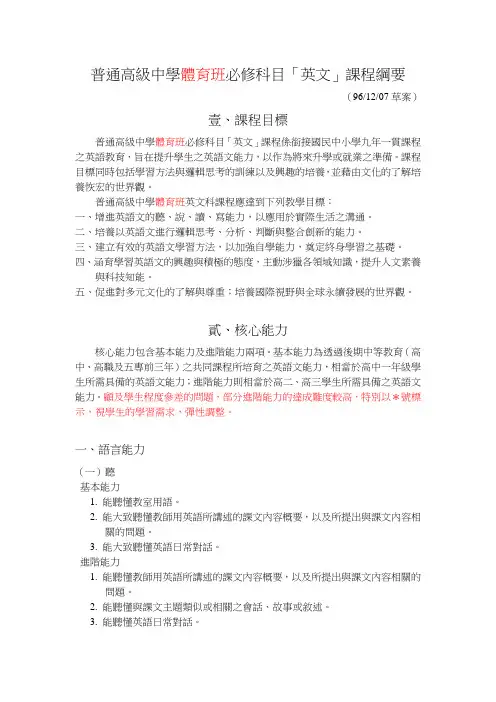
普通高級中學體育班必修科目「英文」課程綱要(96/12/07草案)壹、課程目標普通高級中學體育班必修科目「英文」課程係銜接國民中小學九年一貫課程之英語教育,旨在提升學生之英語文能力,以作為將來升學或尌業之準備。
課程目標同時包括學習方法與邏輯思考的訓練以及興趣的培養,並藉由文化的了解培養恢宏的世界觀。
普通高級中學體育班英文科課程應達到下列教學目標:一、增進英語文的聽、說、讀、寫能力,以應用於實際生活之溝通。
二、培養以英語文進行邏輯思考、分析、判斷與整合創新的能力。
三、建立有效的英語文學習方法,以加強自學能力,奠定終身學習之基礎。
四、涵育學習英語文的興趣與積極的態度,主動涉獵各領域知識,提升人文素養與科技知能。
五、促進對多元文化的了解與尊重;培養國際視野與全球永續發展的世界觀。
貳、核心能力核心能力包含基本能力及進階能力兩項。
基本能力為透過後期中等教育(高中、高職及五專前三年)之共同課程所培育之英語文能力,相當於高中一年級學生所需具備的英語文能力;進階能力則相當於高二、高三學生所需具備之英語文能力。
顧及學生程度參差的問題,部分進階能力的達成難度較高,特別以*號標示,視學生的學習需求,彈性調整。
一、語言能力(一)聽基本能力1. 能聽懂教室用語。
2. 能大致聽懂教師用英語所講述的課文內容概要,以及所提出與課文內容相關的問題。
3. 能大致聽懂英語日常對話。
進階能力1. 能聽懂教師用英語所講述的課文內容概要,以及所提出與課文內容相關的問題。
2. 能聽懂與課文主題類似或相關之會話、故事或敘述。
3. 能聽懂英語日常對話。
*4. 能聽懂英語教學廣播節目。
5. 能聽懂公共場所廣播的內容,如捷運、車站、機場廣播。
*6. 能大致聽懂英語影片及國內英語新聞報導的內容。
(二)說基本能力1. 能使用主要的英語教室用語。
2. 能以英語尌課文內容進行簡單的問答。
3. 能參與課堂上的英語口語練習。
4. 能以英語進行簡易的口語溝通。
5. 能以英語簡單描述日常事物。
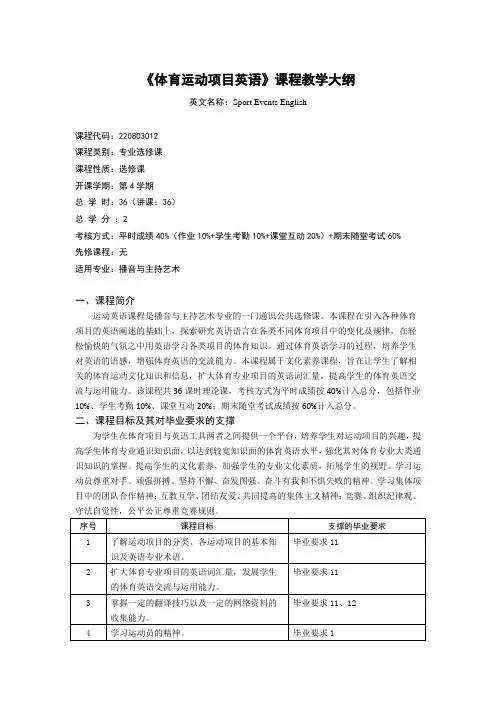
《体育运动项目英语》课程教学大纲英文名称:Sport Events English课程代码:220803012课程类别:专业选修课课程性质:选修课开课学期:第4学期总学时:36(讲课:36)总学分:2考核方式:平时成绩40%(作业10%+学生考勤10%+课堂互动20%)+期末随堂考试60%先修课程:无适用专业:播音与主持艺术一、课程简介运动英语课程是播音与主持艺术专业的一门通识公共选修课。
本课程在引入各种体育项目的英语阐述的基础上,探索研究英语语言在各类不同体育项目中的变化及规律,在轻松愉快的气氛之中用英语学习各类项目的体育知识。
通过体育英语学习的过程,培养学生对英语的语感,增强体育英语的交流能力。
本课程属于文化素养课程,旨在让学生了解相关的体育运动文化知识和信息,扩大体育专业项目的英语词汇量,提高学生的体育英语交流与运用能力。
该课程共36课时理论课,考核方式为平时成绩按40%计入总分,包括作业10%、学生考勤10%、课堂互动20%;期末随堂考试成绩按60%计入总分。
二、课程目标及其对毕业要求的支撑为学生在体育项目与英语工具两者之间提供一个平台,培养学生对运动项目的兴趣,提高学生体育专业通识知识面,以达到较宽知识面的体育英语水平,强化其对体育专业大类通识知识的掌握。
提高学生的文化素养,加强学生的专业文化素质,拓展学生的视野。
学习运动员尊重对手、顽强拼搏、坚持不懈、奋发图强、奋斗有我和不惧失败的精神。
学习集体项目中的团队合作精神;互教互学、团结友爱、共同提高的集体主义精神;竞赛、组织纪律观、三、课程内容及要求Lesson 1. IOC & IPC & International Comprehensive Sport CompetitionsTeaching Contents:1. IOCOlympic Rings, Olympic Spirit, Olympic Motto, Olympic Anthem, Olympic Mascot, Olympic Torch Relay, Ancient Olympic Games, Olympic Games of Modern Times2.IPCParalympic Games, Special Olympic Games3.International Comprehensive Sport CompetitionsYouth Olympic Games, Asian Games, UniversiadeStudents’ expected learning results:Obtaining the knowledge related to IOC and IPC; Grasping the main idea and structure of the text; Learning new professional terms and expressionsKey points:Comprehension of the text; Learning new words and phrasesDifficult points:Major professional terms and useful expressions; Dealing with some difficult sentencesLesson 2. Sports Events & General TermsTeaching Contents:1.Sports on the Olympic ProgrammeSummer Sports, Winter Sports2.Recognized Sports3.Other Sports4.General TermsStudents’ expected learning results:Obtaining the knowledge related to sports events and general events; learning the new words and expressionsKey points:Sports Events; General TermsDifficult points:Major professional terms and useful expressionsLesson 3. Football & BasketballTeaching Contents:1.FootballFIFA, World Cup, History, Development, Soccer, Goalkeeper, Defensive Players, Midfield Players, Offensive Players, Pitch, Aim2.BasketballNBA, History, Court, Field Goal, Free Throw, Regular Season, Playoff, Required Conditions, CBAStudents’ expected learning results:Obtaining the knowledge related to football and basketball; Grasping the main idea and structure of the text; Learning new professional terms and expressions Key points:Comprehension of the text; Learning new words and phrasesDifficult points:Major professional terms and useful expressions; Dealing with some difficultsentencesLesson 4. Volleyball & Beach Volleyball & HandballTeaching Contents:1.V olleyball& Beach VolleyballFIVB, Play Area, Basic Skills, Defensive Skills2.HandballIAHFStudents’ expected learning results:Obtaining the knowledge related to volleyball, beach volleyball and handball; Grasping the main idea and structure of the text; Learning new professional terms and expressionsKey points:Comprehension of the text; Learning new words and phrasesDifficult points:Major professional terms and useful expressions; Dealing with some difficult sentencesLesson 5. Badminton & TennisTeaching Contents:1.BadmintonShuttlecock, Racket, Men’s Singles, Men’s Doubles, Women’s Singles, Women’s Doubles, Mixed Doubles, IBF2.TennisFour Grand Slams, Wimbledon Lawn Champion, US Open, French Open, Australian Open Students’ expected learning results:Obtaining the knowledge related to badminton and tennis; Grasping the main idea and structure of the text; Learning new professional terms and expressions Key points:Comprehension of the text; Learning new words and phrasesDifficult points:Major professional terms and useful expressions; Dealing with some difficult sentencesLesson 6. Table Tennis & HockeyTeaching Contents:1.Table TennisPaddle, Men’s Singles, Men’s Teams, Women’s Singles, Women’s Teams, ITTF, Umpire, Service Judge, Line Umpire, Scorer, Ping Pang Diplomacy, National Game2.Hockeygoalie, curved stick, FIHStudents’ expected learning results:Obtaining the knowledge related to table tennis and hockey; Grasping the main idea and structure of the text; Learning new professional terms and expressions Key points:Comprehension of the text; Learning new words and phrasesDifficult points:Major professional terms and useful expressions; Dealing with some difficult sentencesLesson 7. AthleticsTeaching Contents:1. Track EventsSprint, Middle Distance Running, Long Distance Running, Hurdle, Relay Race, Steeplechase2. Jumping EventsHigh Jump, Pole V ault, Long Jump, Triple Jump3. Throwing EventsShot Put, Discus Throw, Hammer Throw, Javelin Throw4.Race Walking5.Multi-eventsDecathlon, Heptathlon6.MarathonIAAFStudents’ expected learning results:Obtaining the knowledge related to athletics; Grasping the main idea and structure of the text; Learning new professional terms and expressionsKey points:Comprehension of the text; Learning new words and phrasesDifficult points:Major professional terms and useful expressions; Dealing with some difficult sentencesLesson 8. Swimming & Synchronized SwimmingTeaching Contents:1.SwimmingFreestyle, Backstroke, Breaststroke, Butterfly, Individual Medley, Freestyle Relay, Medley Relay, Marathon, FINA2. Synchronized SwimmingWater Ballet, Duet Competition, Team Competition, Solo, Basic Synchro Positions Students’ expected learning results:Obtaining the knowledge related to swimming and synchronized swimming; Grasping the main idea and structure of the text; Learning new professional terms and expressionsKey points:Comprehension of the text; Learning new words and phrasesDifficult points:Major professional terms and useful expressions; Dealing with some difficult sentencesLesson 9. Diving & Water PoloTeaching Contents:1. DivingSpringboard Diving, Platform Diving, Men’s Individual Platform, Men’s Synchronized Platform, Women’s Individual Platform, Women’s Synchronized Platform, Forward, Back, Reverse, Inward, Twisting, Armstand, Straight, Pike, Tuck, Free, Approach, Take-off, Elevation, Execution, Entry2. Water PoloSwimming PoolStudents’ expected learning results:Obtaining the knowledge related to diving and water polo; Grasping the main idea and structure of the text; Learning new professional terms and expressions Key points:Comprehension of the text; Learning new words and phrasesDifficult points:Major professional terms and useful expressions; Dealing with some difficult sentencesLesson 10. Artistic GymnasticsTeaching Contents:1.Artistic GymnasticsFloor Exercise, Pommel Horse, Rings, Vault, Parallel Bars, Horizontal Bar, Uneven Bars, Balance Beam, Apparatus, FIGStudents’ expected learning results:Obtaining the knowledge related to artistic gymnastics; Grasping the main idea and structure of the text; Learning new professional terms and expressions Key points:Comprehension of the text; Learning new words and phrasesDifficult points:Major professional terms and useful expressions; Dealing with some difficult sentencesLesson 11. Rhythmic Gymnastics & TrampolineTeaching Contents:1.Rhythmic GymnasticsIndividual Competition, Group Competition, Rope, Hoop, Ball, Club, Ribbon2. TrampolineMen’s Individual Event, Women’s Individual EventStudents’ expected learning results:Obtaining the knowledge related to rhythmic gymnastics and trampoline; Grasping the main idea and structure of the text; Learning new professional terms and expressionsKey points:Comprehension of the text; Learning new words and phrasesDifficult points:Major professional terms and useful expressions; Dealing with some difficult sentencesLesson 12. Shooting & Archery & FencingTeaching Contents:1. ShootingPistol, Air Pistol, Rapid Fire Pistol, Rifle, Air rifle, Rifle Prone, Skeet, Trap, Double Trap, Three Positions, Shooting from Kneeling Position, Shooting from Standing Position, Shooting from Prone Position, ISSF2. ArcheryMen’s Individual Competition, Men’s Team Competition, Women’s Individual Competition, Women’s Team Competition, IAF3. FencingFoil, Epee, Sabre, Piste, IFFStudents’ expected learning results:Obtaining the knowledge related to shooting, archery and fencing; Grasping the main idea and structure of the text; Learning new professional terms and expressionsKey points:Comprehension of the text; Learning new words and phrasesDifficult points:Major professional terms and useful expressions; Dealing with some difficult sentencesLesson 13. Equestrian & CyclingTeaching Contents:1.EquestrianEventing, Dressage, Jumping, Cross-country Test, FEI2.CyclingTrack, Road, Mountain Bike, BMX, Sprint, Pursuit, Time Trial, UCI, Tour de France Students’ expected learning results:Obtaining the knowledge related to equestrian and cycling; Grasping the main idea and structure of the text; Learning new professional terms and expressions Key points:Comprehension of the text; Learning new words and phrasesDifficult points:Major professional terms and useful expressions; Dealing with some difficult sentencesLesson 14. Rowing & SailingTeaching Contents:1.RowingRacing Boat, Sculls, Single Sculls, Double Sculls, FISA2.SailingSailboat, Yacht, ISAFStudents’ expected learning results:Obtaining the knowledge related to rowing and sailing; Grasping the main idea and structure of the text; Learning new professional terms and expressions Key points:Comprehension of the text; Learning new words and phrasesDifficult points:Major professional terms and useful expressions; Dealing with some difficult sentencesLesson 15. Judo & Taekwondo & WrestlingTeaching Contents:1.JudoJujitsu, Ippon, Waza-ari, Koka, Koko,Tatami, IJF2.TaekwondoKarate, Martial Art, Flying and Spinning Kicks, Punch, WTF3.WrestlingFreestyle Wrestling, Catch-as-catch-can, Greco-Roman style, FILAStudents’ expected learning results:Obtaining the knowledge related to judo, taekwondo and wrestling; Grasping the main idea and structure of the text; Learning new professional terms and expressionsKey points:Comprehension of the text; Learning new words and phrasesDifficult points:Major professional terms and useful expressions; Dealing with some difficult sentencesLesson 16. Boxing & WeightliftingTeaching Contents:1.BoxingFists, Boxing Gloves, Light Flyweight, Flyweight, Bantamweight, Featherweight, Lightweight, Light Welterweight, Welterweight, Light Middleweight, Middleweight, Light Heavyweight, Heavyweight, Super Heavyweight2.WeightliftingClean and Jerk, Snatch, IWF, AttemptStudents’ expected learning results:Obtaining the knowledge related to boxing and weightlifting; Grasping the main idea and structure of the text; Learning new professional terms and expressions Key points:Comprehension of the text; Learning new words and phrasesDifficult points:Major professional terms and useful expressions; Dealing with some difficult sentencesLesson 17. Triathlon & Modern PentathlonTeaching Contents:1.TriathlonSwimming, Cycling, Running, Men’s Olympic Distance Competition, Women’s Oly mpic Distance Competition, ITU2.Modern PentathlonPistol Shooting, Fencing, Swimming, Horse Riding, Running, Men’s Individual Competition, Women’s Individual Competition, UIPMBStudents’ expected learning results:Obtaining the knowledge related to triathlon and modern pentathlon; Grasping the main idea and structure of the text; Learning new professional terms and expressionsKey points:Comprehension of the text; Learning new words and phrasesDifficult points:Major professional terms and useful expressions; Dealing with some difficult sentences四、建议教学安排五、课程成绩评定六、教材及课程资源(一)教材[1] 体育专业英语.(二)课程资源[1] 体育专业英语.[2] 新编体育英语.。
体育英语基础教程Sports English Basic CourseIntroduction:Welcome to the Sports English Basic Course! This course is designed to help you improve your English language skills in the context of sports. Whether you are an athlete, a sports enthusiast, or simply interested in learning about sports in English, this course will provide you with essential vocabulary, phrases, and expressions related to various sports. Let's get started!Lesson 1: Introduction to SportsIn this lesson, we will learn about different sports and their basic rules. You will also learn how to talk about your favorite sport and ask others about theirs.Lesson 2: Sports EquipmentIn this lesson, we will focus on sports equipment. You will learn the names of various sports equipment and how to talk about them in English. This will be useful when discussing specific sports or describing equipment used in a particular sport.Lesson 3: Sports VocabularyThis lesson will cover a wide range of sports vocabulary, including terms used in different sports. You will learn how to talk about common actions, positions, and strategies in sports.Lesson 4: Talking about Sports EventsIn this lesson, you will learn how to discuss sports events, such as matches, tournaments, and championships. You will also learn how to talk about the results of these events and express opinions about them.Lesson 5: Describing Sports PerformancesThis lesson will focus on how to describe sports performances in English. You will learn how to talk about individual performances, team performances, and specific moments during a game or competition.Lesson 6: Sports Idioms and ExpressionsIn this lesson, you will learn common sports idioms and expressions that are used in everyday English. These idioms and expressions are derived from different sports and can be used to enhance your English communication skills.Lesson 7: Sports InterviewsThis lesson will help you understand and participate in sports interviews. You will learn how to ask and answer questions in an interview setting, specifically related to sports.Lesson 8: Sports News and CommentaryIn this lesson, we will focus on sports news and commentary. You will learn how to read, understand, and discuss sports news articles and commentary in English.Conclusion:By the end of this course, you will have gained a solid foundation in sports English. You will be able to talk about different sports, understand sports-related conversations, and confidently participate in discussions about sports. Remember, practice is key, so make sure to use your new skills as often as possible. Good luck and have fun with your sports English journey!。
课程名称:大学英语体育模块课时:2课时教学对象:大学一年级学生教学目标:1. 培养学生对体育英语的兴趣,提高他们的英语听说能力。
2. 帮助学生掌握基本的体育英语词汇和短语,能够进行简单的体育交流。
3. 通过体育活动,增进学生之间的团队合作和沟通能力。
教学内容:1. 体育英语基础词汇和短语2. 体育活动介绍3. 体育英语口语练习教学步骤:第一课时:一、导入1. 教师简要介绍本节课的主题和目标。
2. 学生自由讨论他们对体育活动的看法和兴趣。
二、新授1. 教师带领学生复习并学习以下体育英语基础词汇和短语:- 运动项目:basketball, football, volleyball, tennis, swimming, running, etc.- 体育器材:ball, racket, net, track, pool, etc.- 身体部位:head, shoulder, arm, leg, foot, etc.- 动作描述:hit, kick, serve, jump, run, etc.2. 教师展示图片或视频,让学生用所学的词汇和短语描述体育活动。
三、练习1. 学生分组,进行体育英语口语练习,如:- 描述一个运动项目;- 介绍自己的运动爱好;- 讨论运动对身体的好处。
2. 教师巡回指导,纠正学生的发音和语法错误。
四、总结1. 教师对本节课所学内容进行总结,强调重点词汇和短语。
2. 学生分享自己的学习心得和收获。
第二课时:一、复习1. 教师带领学生复习上节课所学的基础词汇和短语。
2. 学生进行小组竞赛,看谁能够用所学的词汇和短语描述体育活动。
二、新授1. 教师介绍几种常见的体育活动,如:- 篮球:basketball- 足球:football- 网球:tennis- 羽毛球:badminton- 游泳:swimming2. 教师讲解这些体育活动的起源、规则和特点。
三、练习1. 学生分组,进行角色扮演,模拟一场篮球比赛或足球比赛。
综合英语教程体育英语专业第三册课程设计一、课程背景体育英语是当今世界越来越热门的课程,随着世界体育事业的不断发展,体育英语的需求也越来越大。
作为体育英语专业的学生,在掌握好语言基础的同时,还需要学习体育领域中的专业术语和知识。
因此,在本课程设计中,我们将结合综合英语教程和体育英语专业的特点,为学生提供全面、专业、实用的课程内容和教学方法。
二、课程目标1.掌握体育英语基础知识和专业术语;2.培养良好的英语听说读写能力;3.提高学生的综合素质和体育领域的学科水平;4.提高学生的英语运用能力和实战能力;5.培养学生的团队协作能力和创新意识。
三、课程内容Unit 1:Introduction to Sports•Sports and Society•Key Vocabulary and Phrases•Listening Comprehension: Sports NewsUnit 2:Athletic Trning•Exercise Science and Kinesiology•Sport Nutrition•Body Systems and Athletic Performance•Listening Comprehension: Interviews with Trners Unit 3:Sports Psychology•Psychological Factors Affecting Sports Performance•Behavioral, Cognitive and Psychophysiological Approaches to Sports Psychology•Goal Setting and Communication Skills•Listening Comprehension: Sports Psychology Podcasts Unit 4:Sports Medicine•Basics of Sports Injury•Injury Prevention and Rehabilitation•Medical Practices and Equipment Used in Sports Medicine•Listening Comprehension: Interviews with Sports Medicine ExpertsUnit 5:Sports Marketing•Sports Sponsorship and Branding•Sports Media, Broadcasting and Advertising•Business Principles in Sports Management•Listening Comprehension: Sports Marketing Podcasts四、教学方法本课程采用现代化的教学方法,包括教师讲授、小组讨论、案例分析和情景模拟等多种形式。
课程名称:高中体育英语课时:1课时教学目标:1. 通过本节课的学习,学生能够掌握基本的体育英语词汇和表达方式。
2. 培养学生运用英语进行体育交流的能力,提高学生的口语表达能力。
3. 增强学生对体育运动的兴趣,促进学生身心健康。
教学重点:1. 体育英语基本词汇的掌握。
2. 体育活动中常用句型的运用。
教学难点:1. 学生在真实情境中运用英语进行交流。
2. 提高学生的自信心,克服在英语交流中的紧张情绪。
教学准备:1. 教学课件:包含体育英语词汇、句型及图片。
2. 音频资料:相关体育英语对话和歌曲。
3. 教学器材:运动器材(如篮球、足球等)。
教学过程:一、导入1. 教师用英语简单介绍本节课的主题和目标。
2. 学生听英语歌曲《You Can Do It!》,激发学习兴趣。
二、新授1. 教师展示体育英语词汇卡片,引导学生说出对应的中文含义。
2. 学生跟读并模仿发音,巩固词汇。
3. 教师讲解体育活动中常用的句型,如:“Let’s play football!”、“How are you doing?”等。
三、练习1. 学生分组进行体育英语对话练习,如:“What sport do you like?”、“I like playing basketball.”等。
2. 教师巡回指导,纠正发音和语法错误。
四、拓展1. 教师播放一段体育英语视频,引导学生观看并总结视频中的关键信息。
2. 学生分组讨论,分享自己的观看感受和所学知识。
五、巩固1. 教师发放练习题,学生独立完成。
2. 教师讲解练习题,检查学生掌握情况。
六、总结1. 教师对本节课所学内容进行总结,强调重点和难点。
2. 学生分享学习心得,提出疑问。
七、作业1. 学生课后复习本节课所学词汇和句型。
2. 拍摄一段体育活动视频,用英语进行介绍。
教学评价:1. 观察学生在课堂上的参与度和学习兴趣。
2. 检查学生的口语表达能力和语法运用情况。
3. 收集学生的课后作业,了解学生的学习效果。
---一、课程信息课程名称:初中体育英语课程授课年级:[具体年级]授课班级:[具体班级]授课时间:[具体日期] [具体时间]授课教师:[教师姓名]---二、教学目标1. 知识目标:- 学生能够掌握基本的体育英语词汇和短语。
- 学生能够理解简单的体育指令和规则。
- 学生能够运用英语进行简单的体育交流和描述。
2. 技能目标:- 学生能够运用所学词汇和短语进行日常体育活动中的交流。
- 学生能够在体育活动中使用正确的指令和规则。
- 学生能够通过听、说、读、写等活动提高英语应用能力。
3. 情感态度目标:- 学生能够对体育英语产生兴趣,积极参与课堂活动。
- 学生能够通过体育英语学习增强自信心和团队合作精神。
- 学生能够认识到英语在体育交流中的重要性。
---三、教学重难点1. 重点:- 体育英语基础词汇和短语的学习。
- 体育指令和规则的理解和应用。
2. 难点:- 在实际体育活动中运用英语进行有效交流。
- 对复杂体育规则的理解和运用。
---四、教学准备1. 教师准备:- 教学课件或教材。
- 相关体育图片、视频资料。
- 教学活动道具和设备。
2. 学生准备:- 学习笔记本。
- 运动装备。
---五、教学过程1. 导入(5分钟)- 通过简单的英语问候和自我介绍,营造轻松的学习氛围。
- 利用图片或视频展示不同体育项目,激发学生学习兴趣。
2. 新课讲解(15分钟)- 教授基本的体育英语词汇和短语,如:football, basketball, run, jump, etc.- 通过实物或动作演示,帮助学生理解词汇含义。
- 讲解简单的体育指令和规则,如:start, stop, left, right, etc.3. 实践练习(20分钟)- 学生分组进行简单的体育活动,如:传球、跑步等。
- 教师巡回指导,纠正学生的英语发音和动作。
4. 小组合作(15分钟)- 学生分组设计简单的体育游戏,并用英语描述游戏规则和步骤。
- 各组展示游戏,其他学生评价。